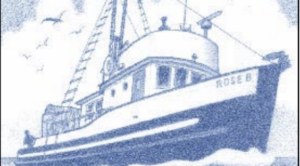
A 1999 report to Congress by the U.S. Department of Commerce’s National Marine Fisheries Service listed 98 species as overfished’that is, experiencing fewer or smaller fish each year because of too much fishing’with another five species approaching an overfished condition. For 674 species, or 75 percent of all species it assessed, the agency does not know if they are overfished or not (NMFS 1999).
Ocean fisheries provide the classic case of the ‘tragedy of the commons,’1 in which lack of ownership of jointly exploited fish stocks often leads to depletion of the stocks.(2)
In a commons situation, entering the fishing grounds first and capturing the fish fastest is a compelling strategy. This is when search and capture costs are the lowest. Each fisher is motivated to invest in equipment (e.g., faster boats and better detection devices) that improve the chances of winning the race for the fish’equipment that would not be necessary if the fishery were not under the strain of such competition. Not only do the stocks decline, but fishing becomes wastefully expensive as too many fishers invest in too much capital to catch too few fish.
Economist Frederick Bell was one of the first to verify empirically the overexploitation of a commons fishery open to all. Studying New England’s northern lobster fishery in 1966, he found that an efficient output of lobster would have occurred at 17.2 million pounds. To attain this output, the efficient number of lobster traps would have been 433,000. However, during 1966 Bell found that fishers employed too much capital’ 891,000 traps’to harvest too many lobsters’ 25 million pounds (Bell 1972, 156).
Government regulation has been the primary tool for ending the tragedy of the commons. However, because government regulators do not own the resource, they typically ignore the economic factors that a private resource owner must consider in order to sustain maximum profits year after year’the situation that reflects the best use to society of the resource.
Regulations have led to enormous waste. The Pacific salmon fishery provides a classic example. Early in the twentieth century regulators prohibited the use of fish traps such as rock or pole barricades used to trap salmon in tidal waters (Allen and Charles 1992, 67). Such devices had been perfected by Indians, who once held exclusive fishing rights to sites along the rivers of the Northwest where the fish returned from the ocean to spawn. They were careful to allow escapement for future production. With traps eliminated, chasing salmon in the oceans commons became the dominant form of harvest. Fishers began to use very expensive, sophisticated equipment’ equipment that became so effective that salmon were overexploited.
Facing reduced salmon numbers, regulators restricted the number of fishermen and the length of the season. So entrepreneurial fishers bought still bigger boats, better detection equipment, and more efficient nets. To plug these loopholes, regulators established other layers of regulations. The salmon catch was ultimately controlled, but the approach was wasteful, as more labor and capital were applied to catch fewer fish. Fishers were forced to fish longer in less productive areas with more expensive equipment (Crutchfield and Pontecorvo 1969).
In addition to overcapitalization, the regulatory process spurred sometimes absurd restrictions. For example, Maryland oystermen at one time could use dredges but had to tow them behind sailboats on all but two days of the week, when motorized boats were allowed (Christy and Scott 1965, 15Ð16). In some Alaskan fisheries, fishing boats were limited to 50 feet in length (Crutchfield and Pontecorvo 1969, 46).
The Magnuson Fishery Conservation and Management Act of 1976 was supposed to correct these problems. The law set the stage for the removal of foreign fishing fleets and the development of domestic fisheries. Foreign fishing had been blamed for overfishing, so the act at least addressed this problem. As for the domestic fishing sector, the act created eight regional councils with the authority to ‘establish a system for limiting access to the fishery in order to achieve optimum yield.’ Optimum yield in this case was expected to take into account economic variables, such as interest rates, fish values, and the cost of alternative technologies.
The Magnuson legislation eliminated uncontrolled foreign fishing out to 200 miles from U.S. shores and called for economic considerations in regulatory policy. However, major problems remain. The legislation encouraged licensing entrants to limit the number of fishers or vessels in a fishery, but limiting entrants does not stop the race for the fish. A few powerful fishing vessels can do in a few minutes what used to take days.
Nor has the act improved the government’s ability to assess stock conditions in a timely fashion. In 1998, for example, the Marine Fisheries Service reported to Congress that the majority of groundfish species off Washington, Oregon, and California were not overfished and were not even approaching an overfished condition (NMFS 1998). A year later, the Department of Commerce on behalf of NMFS declared the Pacific groundfish fishery a ‘disaster’ due to overfishing. It appears that the agency had used three-year-old data to make its 1998 stock assessments of Pacific Coast groundfish (General Accounting Office 2000, 10). For its 1999 assessment the agency used more recent information and found that stocks had been severely depleted.
Given the long history of regulatory failure and growing fishing pressures, it is time to consider policy alternatives based on property rights. One approach gaining acceptance is to establish individual transferable quotas (ITQs), which guarantee each fisher a specific share of the total allowable catch before the season begins. Another is to establish fullfledged property rights either to fishing areas or to the fish themselves. The more secure the property rights, the healthier fish populations and fishing communities will be.
Notes
1. The term ‘tragedy of the commons’ was taken from Garrett Hardin’s influential article. See Hardin (1968).
2 . Community-run, coastal fisheries are an exception to open access. See Leal (1996).
References
Allen, Jane, and Patricia Charles. 1992. Spirit! Historic Ketchikan, Alaska. Ketchikan: Historic Ketchikan, Inc.
Bell, Frederick W. 1972. Technological Externalities and Common-Property Resources: An Empirical Study of the U.S. Northern Lobster Fishery. Journal of Political Economy 80(Jan-Feb): 148Ð58.
Christy, Francis T., and Anthony Scott. 1965. The Common Wealth in Ocean Fisheries Baltimore: John Hopkins University Press.
Crutchfield, J. A., and G. Pontecorvo. 1969. The Pacific Salmon Fisheries: A Study of Irrational Conservation. Baltimore: John Hopkins University Press.
General Accounting Office. 2000. Fishery Management: Problems Remain with the National Marine Fisheries Service’s Implementation of the Magnuson-Stevens Act. GAO/CED-00-69. Washington, DC, April.
Hardin, Garrett. 1968. The Tragedy of the Commons. Science 162:1243Ð48.
Leal, Donald R. 1996. Community-Run Fisheries: Avoiding the ‘Tragedy of the Commons.’ PERC Policy Series, PS-7. Bozeman, MT: Political Economy Research Center, September.
NMFS. 1998. Report to Congress: Status of Fisheries of the United States. Available: http://www.nmfs. gov/sfa/98stat.pdf. Cited: July 10, 2000.
This essay is excerpted from Homesteading the Oceans: The Case for Property Rights in U.S. Fisheries.



